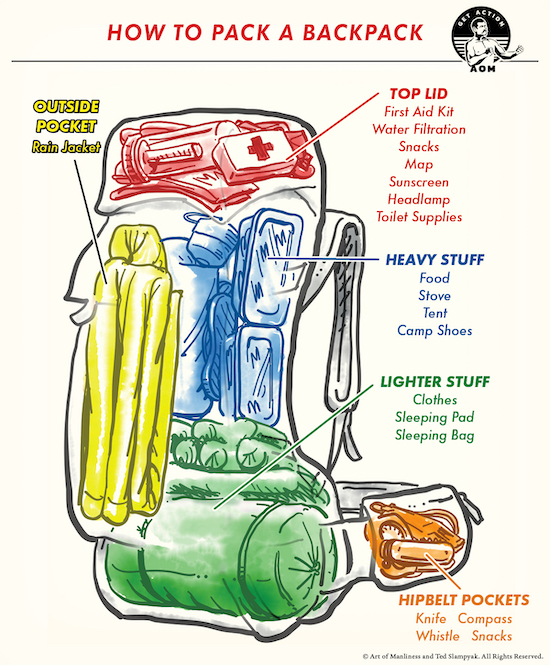Packing a camping backpack well is key to a comfortable and enjoyable trip. What is the best way to pack a camping backpack? The best way involves strategically distributing weight, compressing gear, and keeping essentials easily accessible. A well-packed backpack will save you energy and prevent discomfort on the trail. This guide will show you how to pack your camping backpack efficiently, covering everything from backpacking gear organization to lightweight camping tips.

Image Source: content.artofmanliness.com
Choosing the Right Backpack
Before you even think about packing, make sure you have a backpack that fits you properly. The right size and fit are crucial for comfort and weight distribution.
Backpack Size Matters
Backpacks are measured in liters (L), which indicates the total volume of the pack. Here’s a general guideline:
- Weekend Trips (1-3 nights): 50-75 liters
- Multi-Day Trips (3-5 nights): 65-85 liters
- Extended Trips (5+ nights): 75+ liters
Consider the length of your trip and the gear you’ll need to carry when choosing a pack size.
Fitting Your Backpack
A properly fitted backpack will distribute the weight evenly across your hips and shoulders. Here’s how to fit your backpack:
- Measure Your Torso: Use a flexible measuring tape to measure from your C7 vertebra (the bony bump at the base of your neck) to your iliac crest (the top of your hip bone).
- Adjust the Torso Length: Most backpacks have an adjustable torso length. Match the backpack’s torso length to your measurement.
- Load the Pack: Add some weight to the pack (around 20-30 pounds) to simulate real-world conditions.
- Adjust the Hip Belt: The hip belt should sit snugly on your hip bones. Most of the pack’s weight should rest on your hips.
- Adjust the Shoulder Straps: Tighten the shoulder straps until they are snug but not too tight. They should sit comfortably on your shoulders without digging in.
- Adjust the Load Lifters: These straps connect the top of the shoulder straps to the top of the pack frame. Tighten them until they form a 45-degree angle with the shoulder straps.
- Adjust the Sternum Strap: The sternum strap connects the shoulder straps across your chest. Adjust it until it is snug but not constricting.
Creating Your Camping Backpack Packing List
Before you start packing, create a detailed camping essentials checklist. This will help you stay organized and ensure you don’t forget anything important.
Essential Gear Categories
Here’s a breakdown of essential gear categories:
- Shelter: Tent, footprint, stakes, guylines
- Sleeping: Sleeping bag, sleeping pad, pillow
- Cooking: Stove, fuel, cookware, utensils, food, water filter or purification tablets
- Clothing: Moisture-wicking base layers, insulating layers, waterproof outer layers, socks, hat, gloves
- Navigation: Map, compass, GPS device
- Safety: First-aid kit, headlamp or flashlight, knife or multi-tool, sunscreen, insect repellent
- Personal Items: Toiletries, medications, identification, cash
Camping Essentials Checklist Example
Here’s a sample camping backpack packing list to get you started:
| Category | Item | Notes |
|---|---|---|
| Shelter | Tent | Lightweight and easy to set up |
| Footprint | Protects the tent floor | |
| Stakes | Secure the tent to the ground | |
| Sleeping | Sleeping Bag | Rated for the expected temperatures |
| Sleeping Pad | Provides insulation and comfort | |
| Cooking | Stove | Compact and efficient |
| Fuel | Enough for the duration of the trip | |
| Cookware | Lightweight pot and pan | |
| Clothing | Base Layers | Moisture-wicking material |
| Insulating Layers | Fleece or down jacket | |
| Navigation | Map | Waterproof and up-to-date |
| Compass | Know how to use it | |
| Safety | First-Aid Kit | Comprehensive and tailored to your needs |
| Headlamp | With extra batteries | |
| Personal | Toiletries | Travel-sized |
| Medications | Prescription and over-the-counter |
Backpacking Gear Organization: Strategic Packing
Now that you have your gear and know your backpack, it’s time to start packing! Backpacking gear organization is all about placing items strategically to balance weight and keep essentials accessible.
The Three Zones of Your Backpack
Think of your backpack as having three zones:
- Bottom Zone (Sleeping Zone): Holds lightweight, bulky items that you won’t need until you set up camp.
- Middle Zone (Core Zone): Holds the heaviest items, close to your back, for optimal weight distribution.
- Top Zone (Accessory Zone): Holds frequently needed items for easy access.
How to Load an Internal Frame Backpack
Here’s a detailed guide on how to load your internal frame backpack:
- Bottom Zone:
- Start with your sleeping bag. Stuff it into the bottom compartment. Using a compression sack can save space.
- Pack lightweight clothing items like pajamas or extra socks around the sleeping bag.
- Core Zone:
- Place the heaviest items closest to your back, centered in the pack. This includes your tent (poles can go along the sides if they don’t fit inside the tent body), food bag, and water reservoir (if using one).
- Wrap soft items like clothing around these heavier items to cushion them and prevent shifting.
- Top Zone:
- Place items you’ll need during the day in the top compartment or outer pockets. This includes your rain gear, first-aid kit, snacks, sunscreen, and insect repellent.
- Keep your map and compass easily accessible.
- Outer Pockets:
- Use side pockets for water bottles, trekking poles (if not in use), and other items you want to grab quickly.
- Use the front pocket (if your pack has one) for items like a jacket or gloves.
Packing a Tent in a Backpack
Packing a tent in a backpack can be tricky, but here are a few tips:
- Separate Components: Separate the tent body, rainfly, poles, and stakes. This allows you to distribute the weight more evenly.
- Tent Body and Rainfly: Roll or stuff the tent body and rainfly together. Place them in the middle zone, close to your back.
- Tent Poles: Secure the tent poles to the side of your pack using compression straps, or pack them vertically inside along your back. Be careful not to let the poles poke you.
- Tent Stakes: Place the tent stakes in a small bag and pack them inside a side pocket or within the tent body to prevent them from damaging other gear.
How to Compress Camping Gear
Compression is key to maximizing space in your backpack.
Compression Sacks
Compression sacks are your best friend when it comes to compressing bulky items like sleeping bags and clothing. Here’s how to use them:
- Stuff the Item: Place the item inside the compression sack.
- Close the Top: Secure the top of the sack.
- Tighten the Straps: Tighten the compression straps to compress the item.
Rolling vs. Folding Clothing
Rolling your clothing is generally more space-efficient than folding. Rolling helps to compress the fabric and prevent wrinkles.
Using Stuff Sacks
Stuff sacks are great for organizing smaller items like socks, underwear, and toiletries. They also help to keep your gear dry.
Backpack Weight Distribution
Proper backpack weight distribution is essential for comfort and preventing injuries.
Aim for a Balanced Load
The ideal backpack weight distribution is as follows:
- Heaviest Items: Close to your back, centered in the pack.
- Medium-Weight Items: Around the heaviest items, filling in the gaps.
- Lightweight Items: At the bottom and top of the pack.
Adjusting Weight While Hiking
As you hike, you may need to adjust the weight distribution in your pack. If you feel unbalanced or uncomfortable, stop and rearrange your gear.
Lightweight Camping Tips
Lightweight camping is all about minimizing weight without sacrificing essential gear.
Choose Lightweight Gear
Invest in lightweight versions of essential gear items. This includes:
- Tent: Choose a lightweight tent made from durable materials.
- Sleeping Bag: Opt for a down or synthetic sleeping bag with a good warmth-to-weight ratio.
- Stove: Select a compact and lightweight stove.
Multipurpose Items
Choose items that can serve multiple purposes. For example:
- Bandana: Can be used as a towel, sweatband, or bandage.
- Spork: Combines a spoon and fork.
- Sleeping Bag Liner: Add warmth to sleeping bag, or can be used alone in warm weather.
Leave Unnecessary Items Behind
Be honest with yourself about what you really need. Leave behind any unnecessary items that will only add weight to your pack.
Backpacking for Beginners: Essential Advice
Backpacking can seem daunting, but with the right preparation, it can be an incredibly rewarding experience.
Start with Shorter Trips
Begin with shorter, less challenging trips to get a feel for backpacking. This will allow you to test your gear and build your endurance.
Practice Packing Your Backpack
Practice packing your backpack at home before your trip. This will help you identify any issues with your gear or packing strategy.
Test Your Gear
Test all of your gear before your trip, including your tent, stove, and water filter. This will help you avoid any surprises in the field.
Tell Someone Your Plans
Always let someone know your backpacking plans, including your route and expected return date.
Fathoming Backpack Maintenance
Taking care of your backpack will extend its lifespan and ensure it performs well on future trips.
Cleaning Your Backpack
Clean your backpack regularly to remove dirt, sweat, and food stains. Use a mild soap and water, and air dry the pack completely before storing it.
Storing Your Backpack
Store your backpack in a dry, cool place away from direct sunlight. This will prevent the fabric from deteriorating.
Repairing Your Backpack
Repair any rips or tears in your backpack as soon as possible. Use a needle and thread or seam sealer to fix small holes. For larger repairs, consider taking your pack to a professional repair shop.
Frequently Asked Questions (FAQ)
- Can I bring trekking poles on a plane? Yes, but it’s best to check them rather than carry them on. Regulations may vary depending on the airline.
- What is the best way to clean a water reservoir? Use a cleaning tablet or a mixture of baking soda and water. Rinse thoroughly and air dry completely before storing.
- How do I prevent blisters while hiking? Wear moisture-wicking socks, break in your hiking boots before your trip, and use blister pads on areas prone to rubbing.
- How much water should I carry? A general rule is to carry at least 2 liters of water per day, but this may vary depending on the temperature and your activity level.
- What should I do if it rains while I’m camping? Set up your tent in a sheltered location, wear waterproof clothing, and keep your gear dry by storing it in waterproof bags.

Melody Smith is a passionate writer, outdoor enthusiast, and camping expert based in the Seattle Metropolitan Area. With a deep love for nature and adventure, she shares her personal experiences, tips, and insights on MyCampingPro.com. A seasoned camper and traveler, Melody combines her creative background in design and writing with her love for the great outdoors, offering practical advice and inspiring stories to help others make the most of their outdoor experiences. When she’s not exploring the wilderness, you can find her painting, collecting vintage treasures, or diving into a good book.
